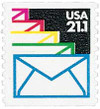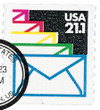
# 2150 - 1985 21.1c Sealed Envelopes
U.S. #2150
1985 21.1¢ Sealed Envelopes
- Paid the rate for non-presorted first-class mail with nine-digit ZIP code
- First multi-colored gravure coil and first coil with a six-digit plate number
- First to use a new thinner paper better suited to gravure printing
- First precanceled stamp with the precancel printed in gravure
Stamp Category: Definitive
Value: 21.1¢; rate for non-presorted first-class mail with nine-digit ZIP code
First Day of Issue: October 22, 1985
First Day City: Washington, D.C.
Quantity Issued: 14,000,000
Printed by: Bureau of Engraving and Printing
Printing Method: Photogravure
Format: Coils of 500
Perforations: 10 Vertically
Why the stamp was issued: This stamp was issued for non-presorted first-class mail. "ZIP" stands for Zoning Improvement Plan and was begun in 1963 to improve the speed of mail processing. In 1978, the Zip+4 was introduced. These extra four digits, primarily for businesses, extended a mailing discount to those using a nine-digit ZIP Code. Although an individual mailing 250 items at one time could use the 21.1¢ rate, he would have to meet the same requirements that apply to business mailers.
About the stamp design: This stamp was designed by Citizens Stamp Advisory Committee design coordinator Richard Sheaff. Dubbed the “Letters” stamp by the USPS, it pictures five envelopes overlapping. The design was unpopular with some, who called it “poster art.”
Special design details: The 21.1¢ Seal Envelopes stamp was available with and without a precancel. #2150 has no precancel, while #2150a has a precancel. This was the first stamp to use a new style of precancel that specifically identified the stamp’s rate usage.
Precancels are stamps canceled before being sold, to make mailing faster and cheaper for customers with large amounts of mail. Bulk mailers use precancels, then pre-sort their mail and save money. The USPS makes these stamps available with and without precancels for two reasons. One reason is to create another variety for stamp collectors. The other, is so the stamps can be used as add-on postage for packages slightly overweight.
About the printing process: This was the first multicolored gravure US coil stamp. All previous gravure coils had all been single color and multicolor coils had been printed by intaglio.
Other notable firsts for this stamp include:
- First US coil with a six-digit plate number
- First to use a new thinner paper better suited to gravure printing
- First precanceled stamp with the precancel printed in gravure (previous precancels were applied by letterpress on the Cottrell presses
First Day City: The First Day ceremony for this stamp was held at a meeting of the Envelope manufacturers Association of America at the Hyatt Regency Capitol Hill in Washington, DC.
Unusual facts about this stamp: It was illegal at the time it was initially announced in March 1985. At that time, postal regulations didn’t allow ZIP+4 commercial first-class mailers to use stamps, the USPS believed it could change that.
History the stamp represents: Prior the creation of Zip codes, the US had postal districts or zones for use in larger cities. As towns and cities grew, the Post Office needed a more organized system to help separate the mail. In 1944, postal inspector Robert Moon submitted a proposal calling for a three-digit Zip code to help sort the mail. For this, Moon is often considered the father of the Zip Code, though it wouldn’t be implemented for nearly 20 years.
Then on July 1, 1963, the Post Office unveiled its new Zip Code system (ZIP stands for Zoning Improvement Plan). In the five-digit codes, the first three numbers represented the sectional center facility, while the last two numbers were often the same as the old postal zone numbers. The introduction of Zip Codes was a big change. Not everyone adapted quickly, and that’s where Mr. Zip comes in.
The design of Mr. Zip is credited to Howard Wilcox, who first created the character for a New York bank’s bank-by-mail campaign. The Post Office Department eventually acquired the rights to the character, changed it slightly, and named him Mr. Zip.
Less than a year after Zip Codes were introduced, Mr. Zip first appeared in the selvage of a US stamp sheet. He was pictured in the bottom left-hand corner of the Sam Houston stamp issued on January 10, 1964. Over the years, Mr. Zip was added to several stamp sheets, leading to a fun new collecting trend. In 1972, the Zippy Collectors Club was created for people collecting stamps with Mr. Zip in the selvage.
Mr. Zip also quickly became infused into American culture. The Post Office was determined to get everyone to use Zip Codes, so they launched a massive advertising campaign. Mr. Zip was featured in newspapers and magazines, TV and radio and was pictured on mail trucks and in post office lobbies.
One of the main goals of Mr. Zip was to appeal to children, so they would grow up knowing to use Zip Codes. Soon Mr. Zip had his very own comic strip and board game. Plus he was pictured on a variety of memorabilia, including a thermos set, and tin bank. Later he would appear on a toy mail car, toy train, jewelry, clothes, mugs, and have his own bobble head. In the 60s, children were also encouraged to include the North Pole’s Zip Code on their letters to Santa.
Celebrities also lent their talents to the Mr. Zip Campaign. Singer Johnny Puleo did a commercial with Mr. Zip. Additionally, Ethel Merman did a promotional jingle to the tune of “Zip-A-Dee-Doo-Dah” that was featured in a Mr. Zip commercial.
The Mr. Zip craze lasted nearly 20 years, until the introduction of Zip+4 in 1983, though he continued to occasionally appear until 1986. Mr. Zip would reemerge in 2013. That year the USPS pictured Mr. Zip in the selvage of a few stamps to honor the 50th anniversary of the Zip Code system.
U.S. #2150
1985 21.1¢ Sealed Envelopes
- Paid the rate for non-presorted first-class mail with nine-digit ZIP code
- First multi-colored gravure coil and first coil with a six-digit plate number
- First to use a new thinner paper better suited to gravure printing
- First precanceled stamp with the precancel printed in gravure
Stamp Category: Definitive
Value: 21.1¢; rate for non-presorted first-class mail with nine-digit ZIP code
First Day of Issue: October 22, 1985
First Day City: Washington, D.C.
Quantity Issued: 14,000,000
Printed by: Bureau of Engraving and Printing
Printing Method: Photogravure
Format: Coils of 500
Perforations: 10 Vertically
Why the stamp was issued: This stamp was issued for non-presorted first-class mail. "ZIP" stands for Zoning Improvement Plan and was begun in 1963 to improve the speed of mail processing. In 1978, the Zip+4 was introduced. These extra four digits, primarily for businesses, extended a mailing discount to those using a nine-digit ZIP Code. Although an individual mailing 250 items at one time could use the 21.1¢ rate, he would have to meet the same requirements that apply to business mailers.
About the stamp design: This stamp was designed by Citizens Stamp Advisory Committee design coordinator Richard Sheaff. Dubbed the “Letters” stamp by the USPS, it pictures five envelopes overlapping. The design was unpopular with some, who called it “poster art.”
Special design details: The 21.1¢ Seal Envelopes stamp was available with and without a precancel. #2150 has no precancel, while #2150a has a precancel. This was the first stamp to use a new style of precancel that specifically identified the stamp’s rate usage.
Precancels are stamps canceled before being sold, to make mailing faster and cheaper for customers with large amounts of mail. Bulk mailers use precancels, then pre-sort their mail and save money. The USPS makes these stamps available with and without precancels for two reasons. One reason is to create another variety for stamp collectors. The other, is so the stamps can be used as add-on postage for packages slightly overweight.
About the printing process: This was the first multicolored gravure US coil stamp. All previous gravure coils had all been single color and multicolor coils had been printed by intaglio.
Other notable firsts for this stamp include:
- First US coil with a six-digit plate number
- First to use a new thinner paper better suited to gravure printing
- First precanceled stamp with the precancel printed in gravure (previous precancels were applied by letterpress on the Cottrell presses
First Day City: The First Day ceremony for this stamp was held at a meeting of the Envelope manufacturers Association of America at the Hyatt Regency Capitol Hill in Washington, DC.
Unusual facts about this stamp: It was illegal at the time it was initially announced in March 1985. At that time, postal regulations didn’t allow ZIP+4 commercial first-class mailers to use stamps, the USPS believed it could change that.
History the stamp represents: Prior the creation of Zip codes, the US had postal districts or zones for use in larger cities. As towns and cities grew, the Post Office needed a more organized system to help separate the mail. In 1944, postal inspector Robert Moon submitted a proposal calling for a three-digit Zip code to help sort the mail. For this, Moon is often considered the father of the Zip Code, though it wouldn’t be implemented for nearly 20 years.
Then on July 1, 1963, the Post Office unveiled its new Zip Code system (ZIP stands for Zoning Improvement Plan). In the five-digit codes, the first three numbers represented the sectional center facility, while the last two numbers were often the same as the old postal zone numbers. The introduction of Zip Codes was a big change. Not everyone adapted quickly, and that’s where Mr. Zip comes in.
The design of Mr. Zip is credited to Howard Wilcox, who first created the character for a New York bank’s bank-by-mail campaign. The Post Office Department eventually acquired the rights to the character, changed it slightly, and named him Mr. Zip.
Less than a year after Zip Codes were introduced, Mr. Zip first appeared in the selvage of a US stamp sheet. He was pictured in the bottom left-hand corner of the Sam Houston stamp issued on January 10, 1964. Over the years, Mr. Zip was added to several stamp sheets, leading to a fun new collecting trend. In 1972, the Zippy Collectors Club was created for people collecting stamps with Mr. Zip in the selvage.
Mr. Zip also quickly became infused into American culture. The Post Office was determined to get everyone to use Zip Codes, so they launched a massive advertising campaign. Mr. Zip was featured in newspapers and magazines, TV and radio and was pictured on mail trucks and in post office lobbies.
One of the main goals of Mr. Zip was to appeal to children, so they would grow up knowing to use Zip Codes. Soon Mr. Zip had his very own comic strip and board game. Plus he was pictured on a variety of memorabilia, including a thermos set, and tin bank. Later he would appear on a toy mail car, toy train, jewelry, clothes, mugs, and have his own bobble head. In the 60s, children were also encouraged to include the North Pole’s Zip Code on their letters to Santa.
Celebrities also lent their talents to the Mr. Zip Campaign. Singer Johnny Puleo did a commercial with Mr. Zip. Additionally, Ethel Merman did a promotional jingle to the tune of “Zip-A-Dee-Doo-Dah” that was featured in a Mr. Zip commercial.
The Mr. Zip craze lasted nearly 20 years, until the introduction of Zip+4 in 1983, though he continued to occasionally appear until 1986. Mr. Zip would reemerge in 2013. That year the USPS pictured Mr. Zip in the selvage of a few stamps to honor the 50th anniversary of the Zip Code system.














